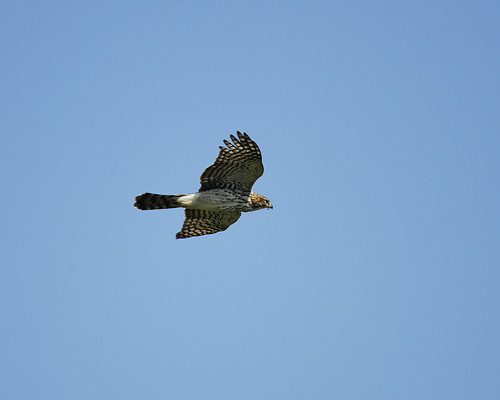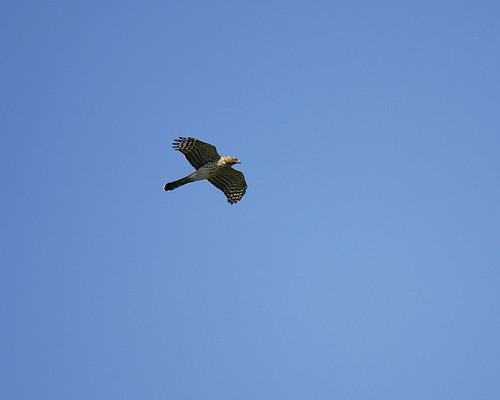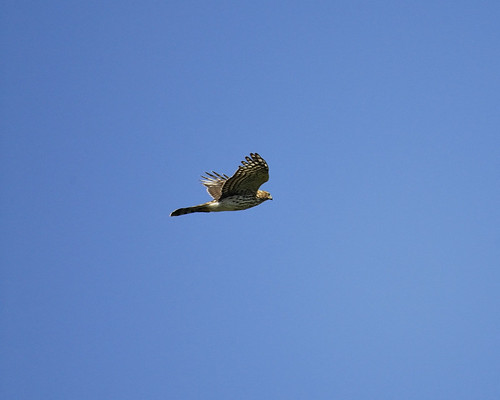tags: Cooper's Hawk, Chicken Hawk, Blue Darter, Accipiter cooperii, birds, mystery bird, bird ID quiz
[Mystery bird] Sharp-shinned Hawk, Accipiter striatus, Cooper's Hawk, also known as a Chicken Hawk or Blue Darter (?!), Accipiter cooperii, photographed at Smith Point, Texas. [I will identify this bird for you in 48 hours]
Image: Joseph Kennedy, 30 September 2009 [larger view].
Nikon D200, Kowa 883 telescope with TSN-PZ camera eyepiece 1/1250s f/8.0 at 1000.0mm iso400.
Please name at least one field mark that supports your identification.
I added more images of the same bird, taken shortly after this photograph. I hope they might help you make an ID. (The photographer says this is a Sharp-shinned Hawk, Accipiter striatus. Not sure if I can get him to respond by describing his reasons for this ID, but will try).
[Mystery bird] photographed at Smith Point, Texas. [I will identify this bird for you in 48 hours]
Image: Joseph Kennedy, 30 September 2009 [larger view].
Nikon D200, Kowa 883 telescope with TSN-PZ camera eyepiece 1/1250s f/8.0 at 1000.0mm iso400.
[Mystery bird] photographed at Smith Point, Texas. [I will identify this bird for you in 48 hours]
Image: Joseph Kennedy, 30 September 2009 [larger view].
Nikon D200, Kowa 883 telescope with TSN-PZ camera eyepiece 1/1000s f/8.0 at 1000.0mm iso400.
[Mystery bird] photographed at Smith Point, Texas. [I will identify this bird for you in 48 hours]
Image: Joseph Kennedy, 30 September 2009 [larger view].
Nikon D200, Kowa 883 telescope with TSN-PZ camera eyepiece 1/1000s f/8.0 at 1000.0mm iso400.





Is is a Barred Hawk?
Juvenile Cooper's Hawk:
* broad, rounded wings heavily barred on undersurface
* long, rounded tail
* head extends well beyond wrists
* underparts marked with elongate teardrops extending to mid-belly.
The notched tail suggests sharp-shinned, rather than Cooper's. But I find raptors hard to tell.
I agree with Sheri, I'm pretty sure this is an immature Cooper's Hawk (Accipiter cooperii): pale underparts with thin black streaks mostly ending at the belly; tail is rounded, pale underneath, and barred with dark bands...
I understand the key field marks that would differentiate the immature Cooper's from the very similar Sharp-shinned are: the thickness and color of the streaks below- Cooper's being relatively fine and with the lower belly mostly white (as above); that there is a reddish color on the side of the head and nape (again, as above); and the rounded vs squared tail with Sharp-shinned Hawks tail feathers being the same length, whereas the outer tail feathers being shorter than the inner feathers on Cooper's Hawks thus looking rounded (as above).
Cornell Lab of Ornithology Hawk ID
Russell - the notched tail doesn't always indicate Sharp-shinned. With Cooper's, sometimes those number 1 tail feathers are so rounded on their ends that it makes their tail appear notched. The fact that the number 6 tail feathers are so much shorter than the number 1 indicates the Cooper's. On the Pacific Coast, the average difference between inner and outer tail feathers for a Coop is about 1 inch, while for Sharp-shins it's about .25 inches.
So yes, agree with Sheri and David - juvenile Cooper's Hawk. Juvenile because of the brown streaking on the body, rather than reddish barring the adults would have. (Also lacks the dark cap that the adult would have as well.)
I think I'm going to disagree with the crowd this time. The blobby nature of the streaks on the breast, the broad secondaries and heavy body, and the strong wedge shape to the tail all suggest Northern Goshawk to me, as does the apparent irregular shape to the tail bands.
Most young Goshawks show streaking to the undertail coverts, but Wheeler shows several that approach Cooper's Hawk in this.
no change Grrl, I'm sticking to my initial ID which supports the description by that shell collector, William!
(immediately discounting the proposed Northern Goshawk possibility because the streaking below very clearly stops short of the belly)
okay, i'll try to get the photographer to peek in here and either comment or send email to me regarding this ID. if/when he does, i'll share what he says.
note the white belly and rounded tail, both distinguishing Cooper's from Sharp-shinned...
Sharp-shinned (note tail)
Sharp-shinned (note streaking on belly)
This certainly demonstrates how challenging accipiter identification can be, but like David (and no offense intended to the photographer) I'm not prepared to abandon my original identification because this seems to me to be a rather straightforward Cooper's. It would be helpful if someone like Clay Sutton or Brian Wheeler could be persuaded to offer an opinion.
I showed these photos to several people at our hawkwatch at Illinois Beach SP. 2 votes for Cooper's Hawk, 2 "why isn't this a Goshawk?".
Sharpie -- Don't think so.
The following is from a Colorado Field Ornithologists Bird ID Quiz and I suggest you all do the similar blow-by-blow comparison that firstly eliminates Northern Goshawk and then differentiates between a Cooper's and a Sharp-shinned... many of the telling Cooper's field marks support that the bird photographed by Joseph above is indeed a Cooper's Hawk:
In addition:
psweet: Location makes Northern Goshawk a highly unlikely candidate, as both photographer Joseph Kennedy and the chair of the Texas Bird Records Committee noted in recent posts to TEXBIRDS.
Someone just sent me this photo, absolutely a Cooper's Hawk (Sheri and the others are correct). Tawny head that is relatively large and projects well past the wrists, relatively long narrow body, long tail that gradually gets longer towards the center (notched appearance at tip can be shown on all 3 accipiters and is unreliable), wings are fairly straight along the trailing edge, streaking is limited to chest and flanks. All these traits combined identify it as Cooper's, there are many reasons why this bird is not a Sharp-shinned or Goshawk but that would make for a long e-mail.
Jerry Liguori
Thanks for the confirmation, Jerry!
For those who might not be familiar with Jerry's work, he's the author of Hawks from Every Angle: How to Identify Raptors In Flight published by Princeton University Press.
Thanks Jerry!
(Having a fight with Amazon over the Ray Comfort version of Origin; is there another source for your text?)
You can get the book at most book stores or a search on line will work. The Princeton University Press site to order is:
http://press.princeton.edu/titles/8025.html
Jerry
Allright -- I'll concede gracefully -- it's a Cooper's Hawk. For what it's worth, one of our counters who initially voted for Goshawk changed his mind on further review.
As far as locale, I agree that Smith's Point makes Goshawk unlikely. (Actually, I think that the date is a pretty good strike against, as well.) But ... Smith's Point gets an awful lot of birds. I know from a season at Corpus Christi, as well as seasons up here, that one can expect several unlikely birds a season in such a situation.
Thank you Jerry
One of the factors that says "Cooper's Hawk" to me is the relatively large, longish, blocky head. To me (here in CT), Sharpies seem to have relatively smaller, rounder heads. And that tail sure looks rounded to me.
This was an interesting and informative exchange.